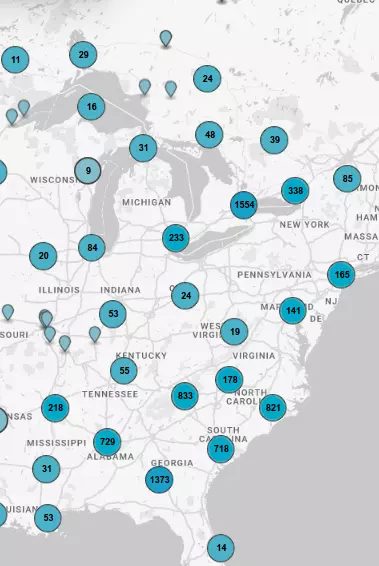General
This Tablet marks the spot at which the LOCOMOTIVE "GENERAL" Was Abandoned by Andrews Raiders Afternoon of April 12th, 1862 Capt. Jas. J. Andrews , with twenty volunteers from Sill´s Brigade,...
- lat34
Trail of Tears Memorial at Old Stone Presbyterian Church
In 1838 federal soldiers forced the Cherokee to march from Georgia to the Indian Territory. That area would later be known as Oklahoma. Thousands died on the march, which began in the midst of...
- lat34
Ringgold Gap May 7, 1864.
Here, through Ringgold Gap, a Federal advance position, Sherman and his army moved forward to begin the campaign against Atlanta and the heart of the South. The Confederate defense, well conceived...
- lat34
Atlanta Campaign Ringgold Gap May 7, 1864.
National Historic Site Atlanta Campaign Ringgold Gap May 7, 1864 Here, through Ringgold Gap, a Federal advance position, Sherman and his amry moved forward to begin the campaign against Atlanta...
- lat34
Old Stone Presbyterian Church War Time Hospital
This church, organized September 2, 1837, before the Cherokee Indians were removed from this area, was the first church organized by white settlers in the bounds of the present Catoosa...
- lat34
Western & Atlantic Depot
This is the only depot between Atlanta and Chattanooga that has been in continuous use since May 9, 1850, when the first train ran over this end of the line. Previous to the coming of the W & A to...
- lat34
Old Federal Road
This highway is part of the Old Federal Road, an early thoroughfare that linked Georgia and west Tennessee across the Indian Country. It began on the southeast boundary of the Cherokees, in...
- lat34
Old Federal Road
For the last eight miles this highway has followed closely the course of the Old Federal Road, northwest Georgia´s earliest vehicular thoroughfare and first postal route. It led this way from the...
- lat34
4th Corps' Route to Tunnel Hill
May 7, 1864. The 4th A.C., marching from Catoosa Springs, moved S. on this road to Tunnel Hill -- Stanley´s div. in advance, followed by Wood & Newton; Maj. Gen. O.O. Howard, commanding. The march...
- lat34
Campaign for Atlanta Began Here
The 4th A.C., marching from Cleveland, Tenn. reached Catoosa Springs May 4, 1864. The 23d A.C., via Cleveland & Red Clay, camped in this vicinity. Both corps moved S. from these positions...
- lat34
Mulberry Grove Plantation
Mulberry Grove which is located approximately 2 miles northeast from this marker is one of the most historic of the old Savannah River plantations. In early Colonial days mulberry trees were...
- lat34
Leet's Tanyard
Residence and Tanyard of the Rev. Arthur I. Leet, (native of Monaghan, Ireland), 1812-1892. A noted landmark of the Chickamauga Campaign; was Gen. Braxton Bragg´s H´dq´rs. [Confed.], Sept. 17,...
- lat34
Nickajack Gap
The road E. ascends Taylor´s Ridge & via Nickajack Gap, crosses E. Chickamauga Cr. Valley. May 7, 1864. Brig. Gen. Judson Kilpatrick´s (3d) Div., Elliott´s Cav. Corps (Army of the...
- lat34
Ringgold Gap November 27, 1863
After the battle of Missionary Ridge, Bragg´s Confederate Army retreated through the gap in disorder towards Dalton, GA. Brig. Gen. Patrick R. Cleburne was ordered to take position in the...
- lat34
Battle of Chickamauga 9 mi.
Nine miles west of here on Saturday and Sunday, September 19th and 20th, 1863, the bloody battle of Chickamauga was fought. Here, Federal forces of about 60,000 under Major-General William...
- lat34
Confederate Hospitals
Here in 1862-1863 were located several Confederate hospitals ~ The Foard, The General, The Bragg, and The Buckner. The Courthouse, Napier´s Hotel, two Churches, several warehouses, and...
- lat34
Catoosa Springs Confederate Hospitals
In 1862-1863 several Confederate hospitals were located here. The sick and wounded Confederate soldiers drank of the health-giving waters of the several mineral springs in this area. Drinking this...
- lat34
Cherokee Springs Confederate Hospital 1/2 mile
One half mile east is the site of Cherokee Springs Confederate Hospital, located here in 1862- 1863. Hundreds of sick and wounded Confederate soldiers were sent to the hospital to rest and...
- lat34
The Napier House
Thomas Thompson Napier built this house in 1836 of heavy local timber prepared by slaves and finishing lumber brought by ox-wagon from Augusta. During the Battle of Chickamauga 20 wounded soldiers...
- lat34
The Whitman House
This house of handmade brick was built about 1863 by Mr. William L. Whitman, a prominent merchant of Ringgold. After the Battle of Ringgold General U.S. Grant established his headquarters here....
- lat34
